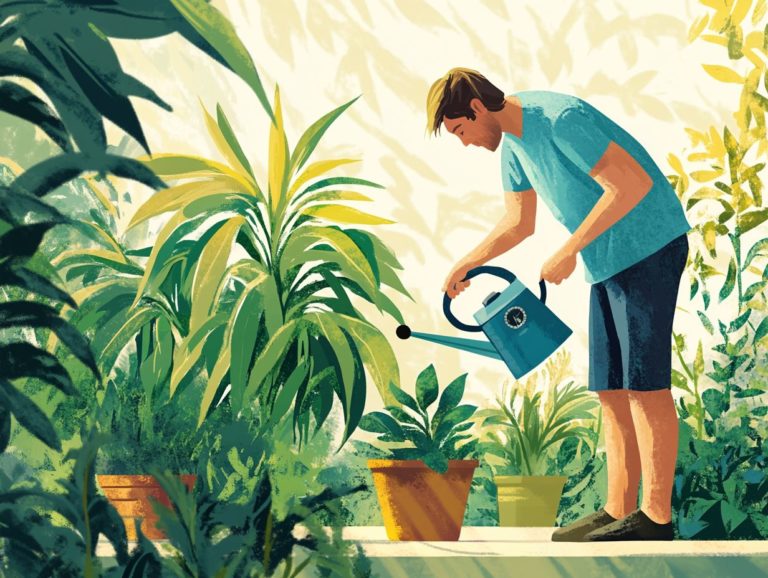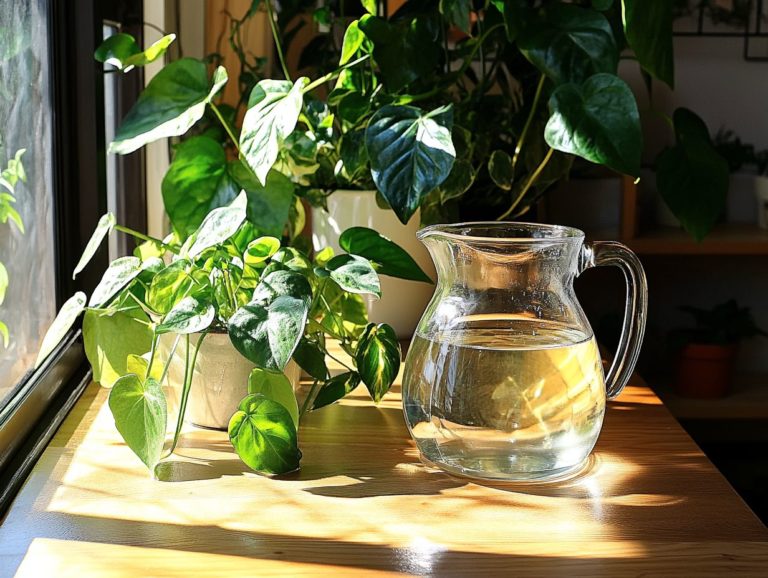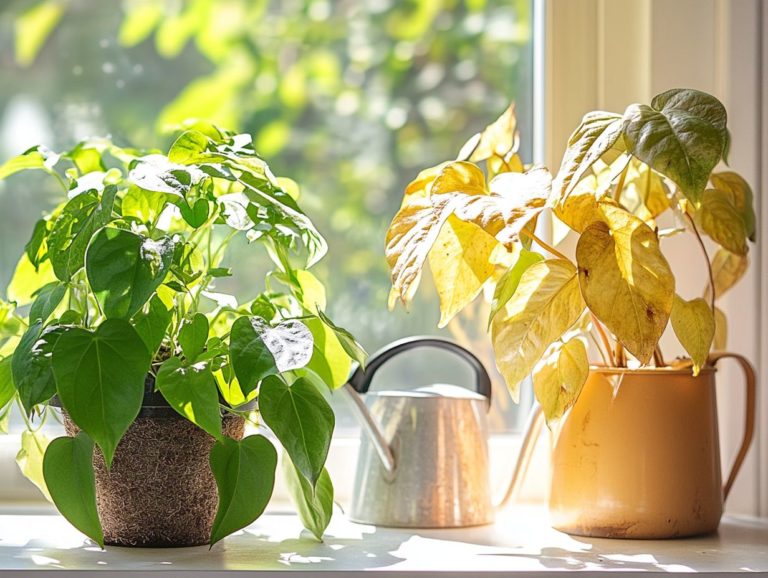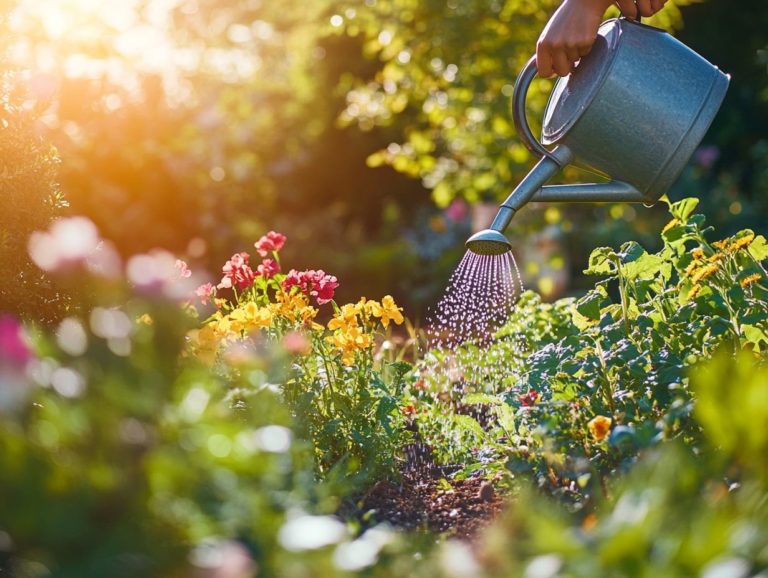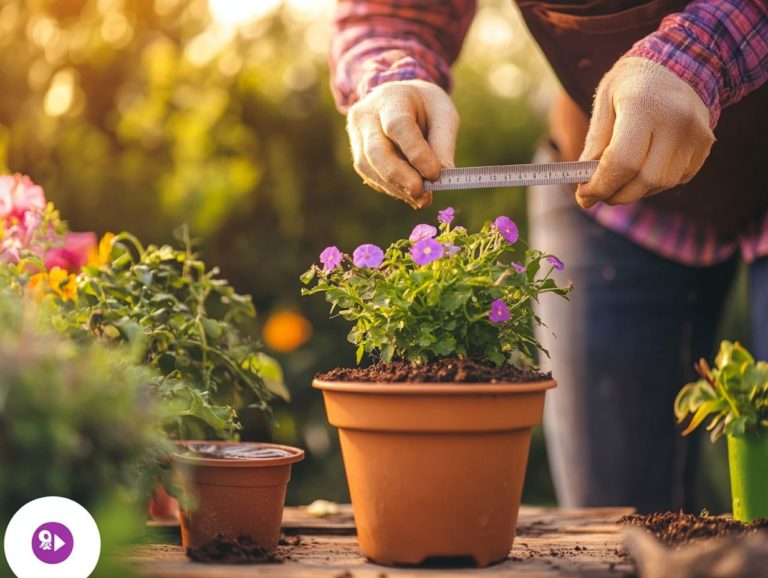Common Watering Mistakes to Avoid
Watering plants may appear simple, yet many gardeners unwittingly commit errors that can impede their plants’ health and growth.
From the pitfalls of overwatering to the oversight of newly transplanted specimens, the manner in which you hydrate your plants can profoundly influence their vitality.
This article unveils common watering missteps, guiding you toward nurturing a flourishing garden.
Uncover crucial insights on timing, technique, and the specific needs of various plants to ensure your greenery thrives, especially in a vegetable garden.
Discover exciting ways to simplify your watering routine and transform your gardening experience!
Contents
- Key Takeaways:
- 1. Overwatering
- 2. Not Watering Enough
- 3. Watering at the Wrong Time of Day
- 4. Using the Wrong Type of Water
- 5. Not Watering Deep Enough
- 6. Watering from Above
- 7. Not Adjusting for Weather Conditions
- 8. Neglecting to Water Newly Planted or Transplanted Plants
- 9. Watering the Leaves Instead of the Roots
- 10. Watering on a Schedule Instead of Based on Plant Needs
- 11. Using Sprinklers Instead of Drip Irrigation
- 12. Not Checking for Proper Drainage
- 13. Watering Too Frequently
- 14. Not Mulching
- 15. Not Considering the Type of Plant and Its Water Needs
- Frequently Asked Questions
Key Takeaways:
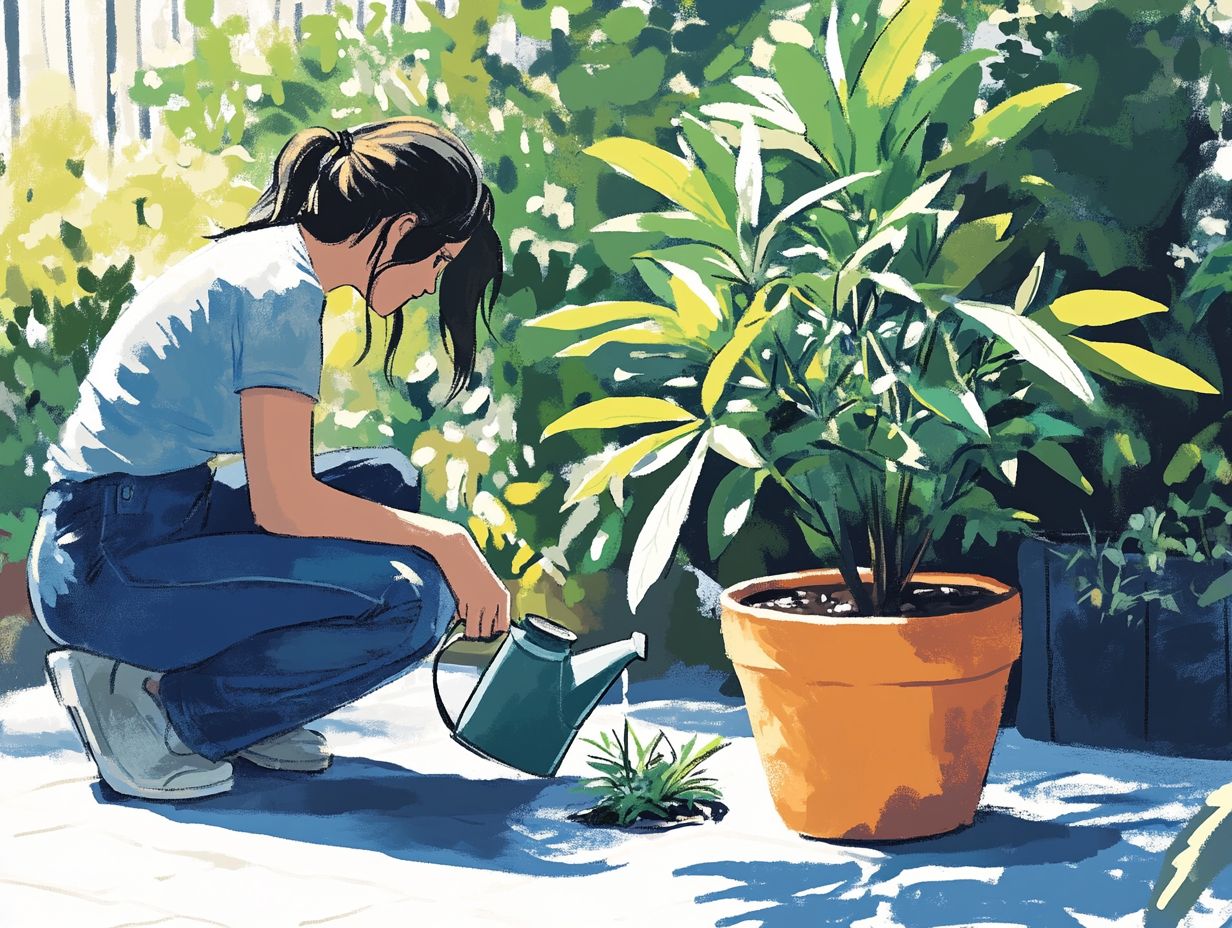
- Avoid overwatering by checking soil moisture levels and only watering when needed.
- Don’t neglect to water newly planted or transplanted plants, as they require more frequent watering.
- Water at the right time of day to prevent water loss due to evaporation and reduce the risk of fungal growth.
1. Overwatering
Overwatering is a common mistake for gardeners. It can lead to root rot and unhealthy plants.
Finding the right water balance is crucial. This ensures your soil and roots stay healthy.
You ll notice signs of overwatering, such as yellowing leaves that look dull or mushy and soil that remains persistently soggy. This restricts oxygen from reaching the roots.
To assess moisture levels, insert your finger into the soil about an inch deep. If it feels wet, it’s wise to refrain from additional watering.
Allowing the soil to dry out between waterings is crucial for maintaining root health.
Experts suggest adjusting your watering techniques based on your plants’ specific needs. For instance, succulents thrive on infrequent yet deep watering, while tropical plants prefer consistent moisture.
This tailored approach helps you sidestep the adverse effects of overwatering, ensuring your garden remains lush and vibrant.
2. Not Watering Enough
Not watering enough can significantly hinder the growth of your plants, leading to wilting leaves and stunted development.
Understanding the moisture needs of your soil is essential for creating an effective watering routine.
If the soil feels dry and crumbly or the leaves droop, your plants need water.
Keep in mind that different plants have unique water requirements. For example, leafy greens like spinach and herbs such as basil generally thrive with more frequent watering, while succulents are quite content in drier conditions.
A dependable way to assess moisture levels is to insert your finger into the soil. If it feels dry up to your first knuckle, it s definitely time to give your plants a drink.
By establishing a consistent watering schedule that takes into account each plant’s specific needs and the seasonal climate, you can ensure they receive the right amount of moisture to truly flourish.
3. Watering at the Wrong Time of Day
Watering your plants at the wrong time of day can significantly impact their health.
It s essential to grasp the optimal times for watering, considering environmental factors like temperature and humidity to maintain ideal soil moisture levels.
Early morning or late afternoon is recommended, as these moments minimize the effects of solar radiation and evaporation.
If you water during peak sunlight, you risk rapid evaporation, meaning less moisture reaches your plant roots.
Morning watering allows your plants to absorb water before the heat kicks in, while late afternoon sessions can help them recover from the evening chill.
As the seasons shift, adjust your watering schedule accordingly. Provide more frequent hydration during the hotter months and scale back in cooler periods.
Keep an eye on local weather forecasts to fine-tune your watering schedule for optimal results.
Start implementing these tips today to nurture your garden into a vibrant oasis!
4. Using the Wrong Type of Water
Using the wrong type of water can negatively impact your plants. It s crucial to consider factors like the pH level, which measures how acidic or alkaline water is, and potential contaminants in your irrigation practices. Opting for rainwater or filtered water can significantly enhance plant health.
While tap water is a common choice, it usually contains chlorine and heavy minerals that might hinder plant growth and soil quality. For example, chlorine can disrupt the natural microbial balance in the soil, leading to weaker and less resilient plants.
On the flip side, rainwater is naturally soft and free of chemicals, making it a gentle and balanced nutrient source. Well water can also be a fantastic alternative, provided it s tested for contaminants. It may be rich in the minerals your plants crave.
By choosing these natural sources over treated water, you can create a healthy and more sustainable growing environment for your garden. This will ultimately lead to healthier foliage. Try these techniques today for a healthier garden!
5. Not Watering Deep Enough
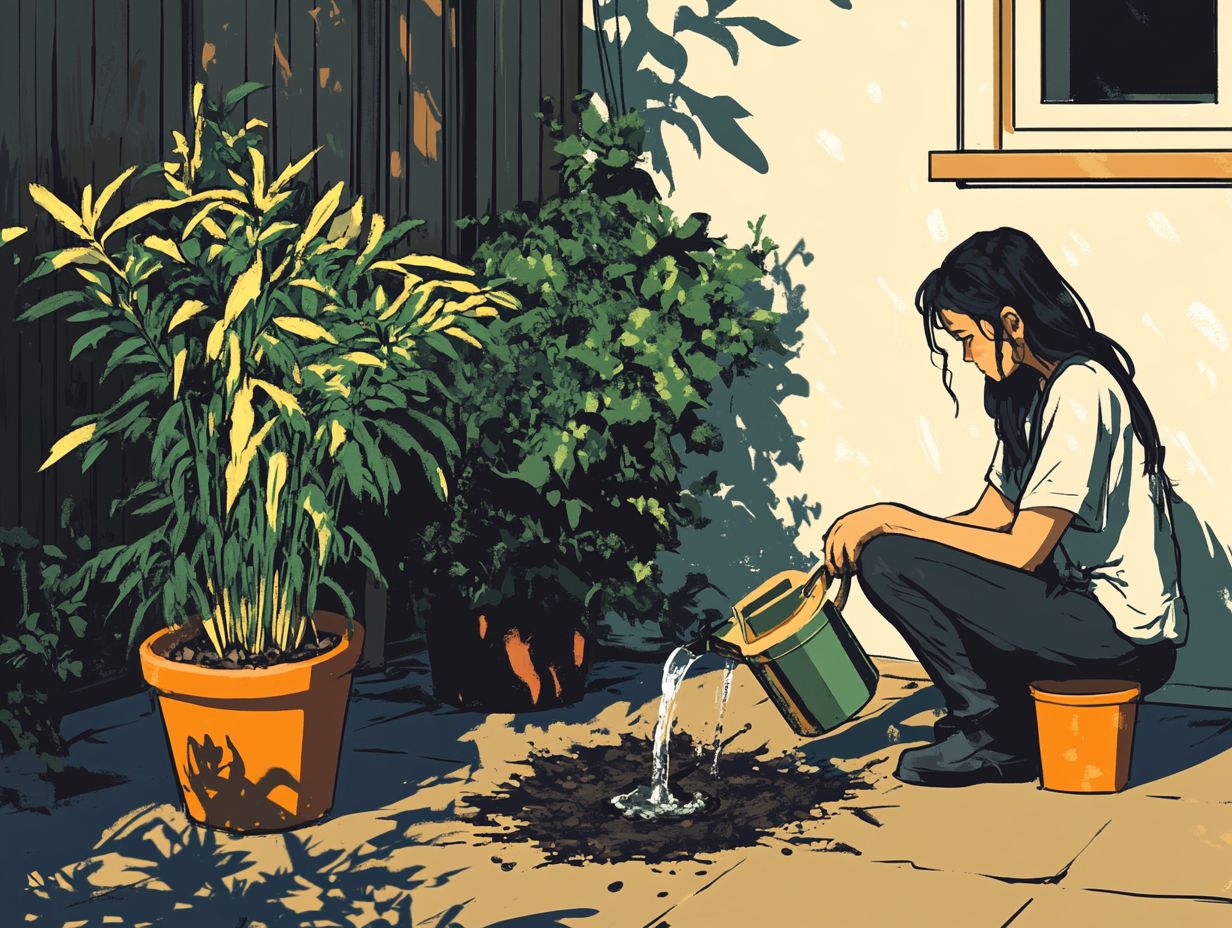
Not watering deeply enough can lead to shallow root systems, making your plants more vulnerable to drought and stress. It s crucial to ensure that water reaches the deeper layers of soil for healthy growth and resilience.
One effective strategy is deep watering. This encourages roots to delve into the soil in search of moisture, strengthening the entire plant structure. Deep-rooted plants are much better equipped to endure dry spells since their roots tap into deeper water reserves.
To monitor how deeply moisture penetrates, grab a moisture meter, a tool to check how wet the soil is. This handy device helps you gauge how far down moisture reaches in the ground. Ensure adequate water penetration by watering slowly and allowing it to soak in, rather than letting it run off.
By adopting this approach, you can cultivate a thriving environment for robust root systems and healthier plants overall!
6. Watering from Above
Watering from above might seem convenient, but it can lead to several problems, including foliar diseases and inefficient moisture absorption. By using appropriate watering techniques that direct moisture straight to the roots, you can significantly enhance your plants’ health.
For foliage-heavy plants, traditional overhead watering can leave leaves wet, creating a perfect breeding ground for fungal infections and pests. This method often encourages shallow root systems, as plants tend to seek moisture from surface water instead of developing deeper, more resilient roots. To avoid these issues, it’s essential to understand the most common missteps in indoor plant care.
To avoid these issues, try using drip irrigation. This method delivers water directly to the root zone, minimizing evaporation and ensuring your plants receive just the right amount of moisture for robust growth.
Using soaker hoses provides even water distribution along rows of plants. This further improves root absorption while cutting down on waste. Embracing these techniques will lead to a thriving garden that stands strong against disease and drought!
7. Not Adjusting for Weather Conditions
Failing to adjust your watering routine according to changing weather conditions can lead you down a tricky path of overwatering or underwatering. It’s crucial to understand your plants’ moisture needs in relation to temperature and humidity for vibrant, healthy growth.
When it rains regularly, take a moment to assess your soil’s moisture retention. Excessive water can suffocate roots and lead to rot, which no plant deserves. Conversely, during intense heat waves, the evaporation rate skyrockets, leaving your soil parched and your plants gasping for water.
To keep your plants optimally hydrated, grab a moisture meter or simply check the top inch of the soil for dampness. For drought-tolerant plants, a gradual watering schedule works wonders, while moisture-loving varieties might need your daily attention during dry spells.
By tailoring your watering practices to the weather, you ll significantly boost your plants’ health and vitality, especially when considering soil moisture levels. Take action now for a flourishing garden!
8. Neglecting to Water Newly Planted or Transplanted Plants
Not watering your newly planted or transplanted plants properly can cause transplant shock. This can lead to stunted growth or even plant death. It s essential to recognize their heightened moisture needs during this critical establishment period.
Ensuring that these delicate young roots have consistent access to moisture is crucial. They are still acclimating to their new environment and lack the extensive root systems of more established plants. In the initial days after planting, check the soil frequently, making sure it remains damp but not waterlogged.
A good rule of thumb is to water deeply once or twice a week, adjusting based on the weather conditions and soil type. This practice helps establish a strong foundation for growth.
Incorporating mulch around the base can further aid in retaining moisture. This creates a nurturing atmosphere for your new seedlings to thrive and ensures their roots remain healthy.
9. Watering the Leaves Instead of the Roots
Watering the leaves instead of the roots can lead to inadequate hydration and increased vulnerability to diseases. Focusing on root watering is essential for maintaining optimal moisture levels in the soil, which is crucial for your plants’ health.
When you apply water directly to the foliage, you risk developing a shallow root system. This inhibits your plants’ ability to effectively absorb nutrients and moisture from the deeper layers of soil.
This method creates a damp environment that encourages fungal growth, leaving your vegetables and herbs susceptible to issues like powdery mildew.
To promote robust growth and resilience, consider using targeted watering methods. Tools like watering cans with narrow spouts or hoses with adjustable nozzles allow for precise application, ensuring moisture reaches the soil near the root zone where it is most beneficial.
This approach nurtures a thriving garden ecosystem, setting you up for gardening success.
10. Watering on a Schedule Instead of Based on Plant Needs
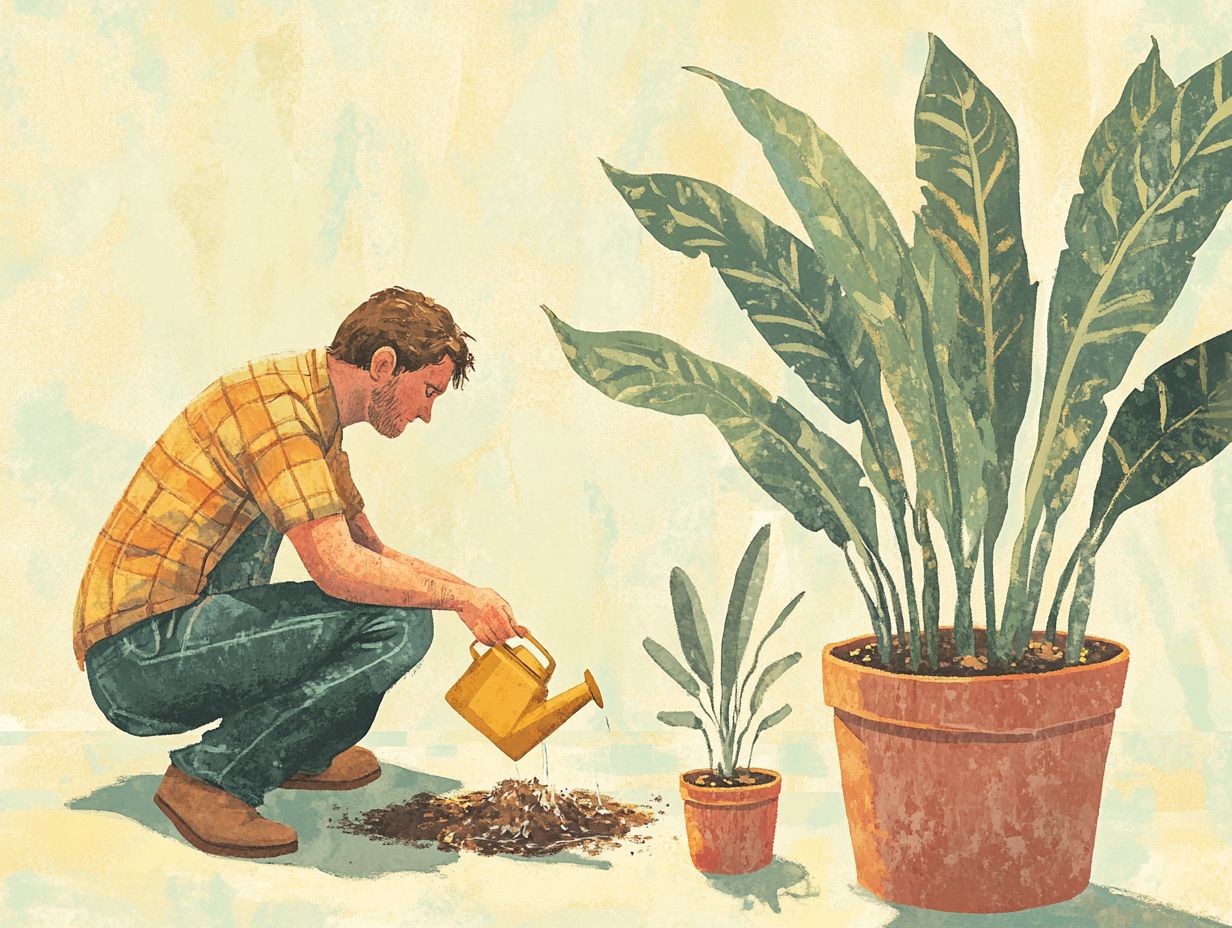
Watering your plants on a rigid schedule without considering their specific needs can throw soil moisture out of balance. Instead, adopt a more responsive watering approach based on real-time soil conditions to foster healthier growth.
Many homeowners may not realize that overwatering can suffocate roots and create a haven for diseases. Underwatering can stress your plants and stunt their development. This is where a moisture meter becomes invaluable; it offers precise readings of soil moisture levels.
Pay attention to environmental factors like temperature fluctuations, humidity, and the growth stage of your plants. Adjust your watering frequency accordingly.
For instance, during the scorching summer months or as seedlings begin to grow, they may need more frequent watering compared to cooler, wetter periods.
11. Using Sprinklers Instead of Drip Irrigation
Opting for sprinklers over drip irrigation might seem convenient, but it often leads to inefficient watering practices. You risk uneven moisture distribution and unnecessary water wastage. In contrast, drip irrigation systems deliver water directly to the roots, fostering healthier plants.
While sprinklers may provide a less labor-intensive solution for larger areas, they often spray water onto the foliage. This can encourage fungal diseases and lead to runoff, especially in drier climates.
Drip irrigation systems, however, deliver water at a slow and steady rate. This minimizes evaporation and ensures that each plant receives just the right amount of moisture for optimal growth.
This targeted approach cuts down on water waste and keeps your garden thriving. It s a smart choice for both you and the environment!
12. Not Checking for Proper Drainage
Neglecting to check for proper drainage can lead to waterlogged soil and root rot, putting your plants at serious risk. Ensuring your garden has adequate drainage is a crucial aspect of successful gardening.
When soil stays saturated for too long, it creates an unwelcoming environment for roots, hindering their ability to absorb essential nutrients and oxygen. You might notice signs like yellowing leaves and stunted growth. An overall lack of vigor in your plants may occur.
To tackle this issue, consider incorporating organic matter like compost. It enhances soil structure, allowing for improved water infiltration and retention. Designing raised beds boosts drainage and provides a controlled environment for soil moisture levels. This makes it easier to cultivate thriving plants.
13. Watering Too Frequently
Water too frequently, and your soil may become waterlogged, suffocating plant roots and inviting diseases. Finding the right balance in your watering frequency is vital for nurturing healthy plant growth.
Recognizing the signs of overwatering is essential for any gardener. Look out for yellowing leaves, wilting despite adequate moisture, or a mushy texture in the soil. These are clear indicators that adjustments are necessary.
Refine your watering habits by examining the type of plants you have. Some thrive on a drier schedule, while others prefer consistent moisture. To avoid common pitfalls, check out the top 7 mistakes in watering indoor plants. Understand how well your soil drains water; for instance, clay soils tend to hold onto water longer than sandy soils.
Incorporating strategies like the finger test or using moisture meters can help you determine optimal watering intervals. This way, your plants receive just the right amount of hydration without the risk of water stress.
14. Not Mulching
Neglecting to mulch can lead to rapid moisture loss from the soil. This makes it difficult to maintain the optimal hydration levels your plants need. By applying mulch, you can effectively conserve soil moisture and regulate temperature.
Beyond keeping soil wet, mulch also plays a crucial role in suppressing weeds, preventing them from competing for valuable nutrients and water. Different types of mulch, such as organic options like bark, straw, or grass clippings, provide varying benefits for your plants. For example, wood chips are perfect for perennial beds, while straw mulch works wonders in vegetable gardens.
To maximize these benefits, proper application techniques are essential. Aim to create a cozy blanket of 2 to 4 inches, spread evenly around the base of your plants, ensuring it doesn t touch their stems. With these practices in place, you ll enjoy healthier plants and reduce the effort you put into maintenance.
15. Not Considering the Type of Plant and Its Water Needs
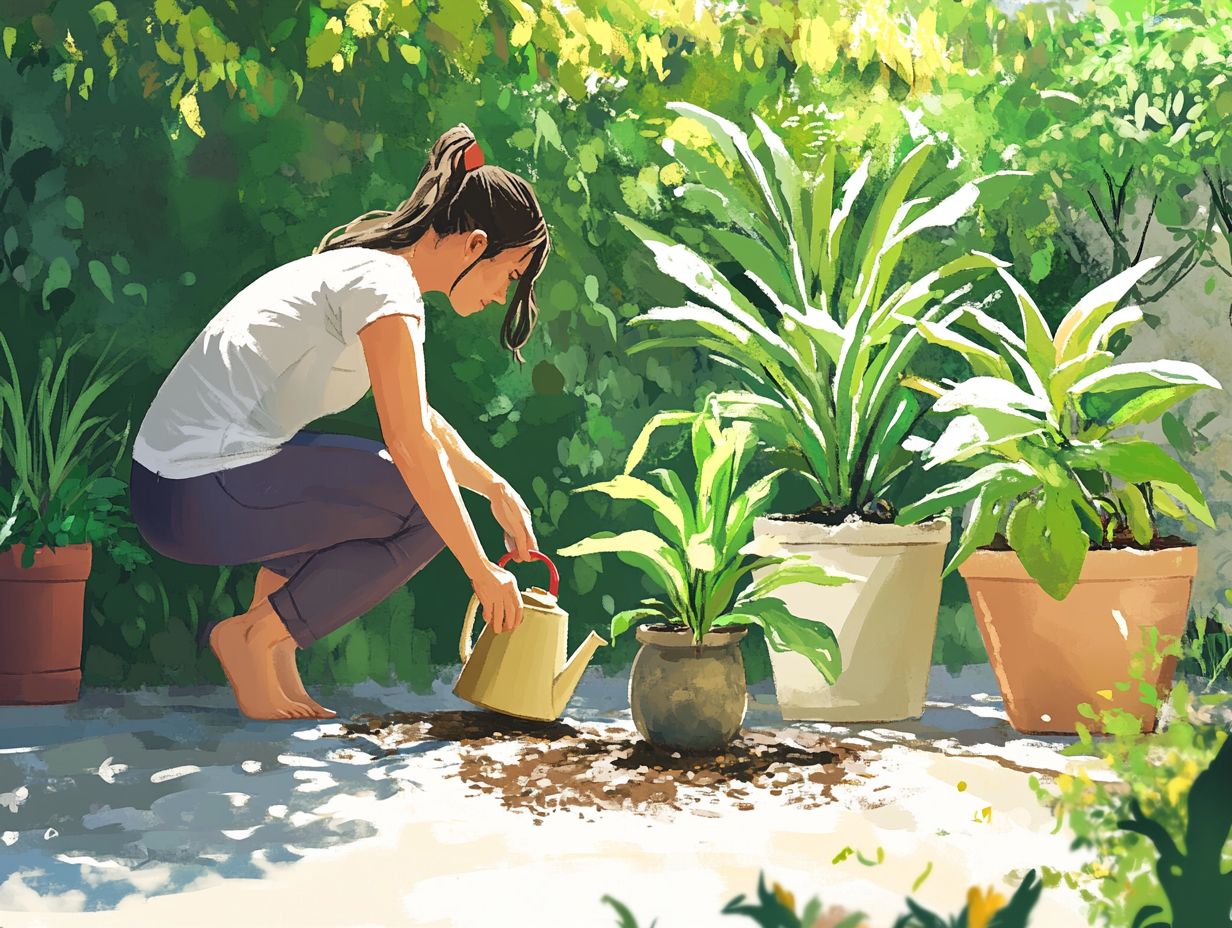
Ignoring the specific water needs of various plant types can lead to improper watering practices, ultimately affecting their growth and health. Know what each plant needs for water. It s key to successful gardening!
For instance, Mediterranean herbs like rosemary and thyme flourish in well-drained soil and prefer drier conditions, making them more drought-resistant. On the other hand, vegetables such as tomatoes and kale need consistently moist soil to support their rapid growth and maximize yield.
Tailoring your watering practices means observing key factors like the plant’s growth stage, local climate, and soil type. By adjusting your watering schedules and amounts based on these characteristics, you’ll create a thriving ecosystem where each plant type can flourish according to its individual needs.
Frequently Asked Questions
What are some common watering mistakes to avoid?
Some common watering mistakes include over-watering, under-watering, watering at the wrong time of day, using the wrong type of watering tool, and watering too frequently.
Why should I avoid over-watering?
Over-watering can drown the roots of plants, causing them to rot and die. It can also lead to the growth of mold and other plant diseases.
Start checking your drainage and watering habits today for a flourishing garden!
How can I avoid under-watering my plants?
Check the soil regularly to see how wet it is. Water your plants when you notice wilting or drooping leaves.
What is the best time of day to water plants?
The morning is the best time to water your plants. This way, the water reaches the roots before the sun evaporates it.
Is it better to use a watering can or a hose?
It depends on your plants. Use a watering can for smaller or delicate plants. A hose works best for larger areas.
How often should I water my plants?
Watering frequency depends on the plant type, location, and weather. Research each plant’s needs, but remember: it’s better to water deeply and less often.

